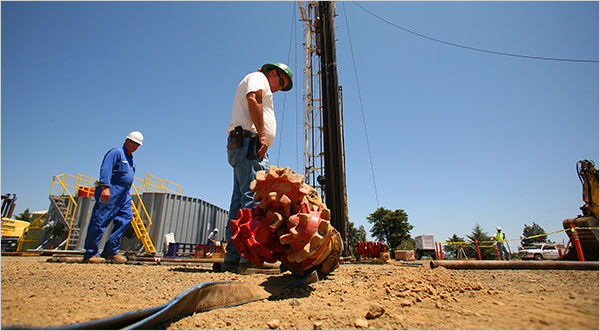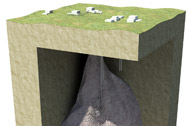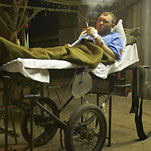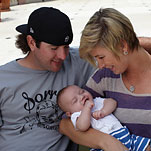BASEL, Switzerland — Markus O. Häring, a former oilman, was a hero in this city of medieval cathedrals and intense environmental passion three years ago, all because he had drilled a hole three miles deep near the corner of Neuhaus Street and Shafer Lane.
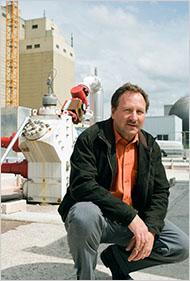
An earthquake halted Markus O. Häring's geothermal project in Basel, Switzerland. More Photos »
Readers’ Comments
Readers shared their thoughts on this article.
He was prospecting for a vast source of clean, renewable energy that seemed straight out of a Jules Verne novel: the heat simmering within the earth’s bedrock.
All seemed to be going well — until Dec. 8, 2006, when the project set off an earthquake, shaking and damaging buildings and terrifying many in a city that, as every schoolchild here learns, had been devastated exactly 650 years before by a quake that sent two steeples of the Münster Cathedral tumbling into the Rhine.
Hastily shut down, Mr. Häring’s project was soon forgotten by nearly everyone outside Switzerland. As early as this week, though, an American start-up company, AltaRock Energy, will begin using nearly the same method to drill deep into ground laced with fault lines in an area two hours’ drive north of San Francisco.
Residents of the region, which straddles Lake and Sonoma Counties, have already been protesting swarms of smaller earthquakes set off by a less geologically invasive set of energy projects there. AltaRock officials said that they chose the spot in part because the history of mostly small quakes reassured them that the risks were limited.
Like the effort in Basel, the new project will tap geothermal energy by fracturing hard rock more than two miles deep to extract its heat. AltaRock, founded by Susan Petty, a veteran geothermal researcher, has secured more than $36 million from the Energy Department, several large venture-capital firms, including Kleiner Perkins Caufield & Byers, and Google. AltaRock maintains that it will steer clear of large faults and that it can operate safely.
But in a report on seismic impact that AltaRock was required to file, the company failed to mention that the Basel program was shut down because of the earthquake it caused. AltaRock claimed it was uncertain that the project had caused the quake, even though Swiss government seismologists and officials on the Basel project agreed that it did. Nor did AltaRock mention the thousands of smaller earthquakes induced by the Basel project that continued for months after it shut down.
The California project is the first of dozens that could be operating in the United States in the next several years, driven by a push to cut emissions of heat-trapping gases and the Obama administration’s support for renewable energy.
Geothermal’s potential as a clean energy source has raised huge hopes, and its advocates believe it could put a significant dent in American dependence on fossil fuels — potentially supplying roughly 15 percent of the nation’s electricity by 2030, according to one estimate by Google. The earth’s heat is always there waiting to be tapped, unlike wind and solar power, which are intermittent and thus more fickle. According to a 2007 geothermal report financed by the Energy Department, advanced geothermal power could in theory produce as much as 60,000 times the nation’s annual energy usage. President Obama, in a news conference Tuesday, cited geothermal power as part of the “clean energy transformation” that a climate bill now before Congress could bring about.
Dan W. Reicher, an assistant energy secretary in the Clinton administration who is now director of climate change and energy at Google’s investment and philanthropic arm, said geothermal energy had “the potential to deliver vast amounts of power almost anywhere in the world, 24/7.”
Power companies have long produced limited amounts of geothermal energy by tapping shallow steam beds, often beneath geysers or vents called fumaroles. Even those projects can induce earthquakes, although most are small. But for geothermal energy to be used more widely, engineers need to find a way to draw on the heat at deeper levels percolating in the earth’s core.
Some geothermal advocates believe the method used in Basel, and to be tried in California, could be that breakthrough. But because large earthquakes tend to originate at great depths, breaking rock that far down carries more serious risk, seismologists say. Seismologists have long known that human activities can trigger quakes, but they say the science is not developed enough to say for certain what will or will not set off a major temblor.
Even so, there is no shortage of money for testing the idea. Mr. Reicher has overseen a $6.25 million investment by Google in AltaRock, and with more than $200 million in new federal money for geothermal, the Energy Department has already approved financing for related projects in Idaho by the University of Utah; in Nevada by Ormat Technologies; and in California by Calpine, just a few miles from AltaRock’s project.
Steven E. Koonin, the under secretary for science at the Energy Department, said the earthquake issue was new to him, but added, “We’re committed to doing things in a factual and rigorous way, and if there is a problem, we will attend to it.”
The tone is more urgent in Europe. “This was my main question to the experts: Can you exclude that there is a major earthquake triggered by this man-made activity?” said Rudolf Braun, chairman of the project team that the City of Basel created to study the risks of resuming the project.
“I was quite surprised that all of them said: ‘No, we can’t. We can’t exclude it,’ “ said Mr. Braun, whose study is due this year.
“It would be just unfortunate if, in the United States, you rush ahead and don’t take into account what happened here,” he said.
Basel’s Big Shock

